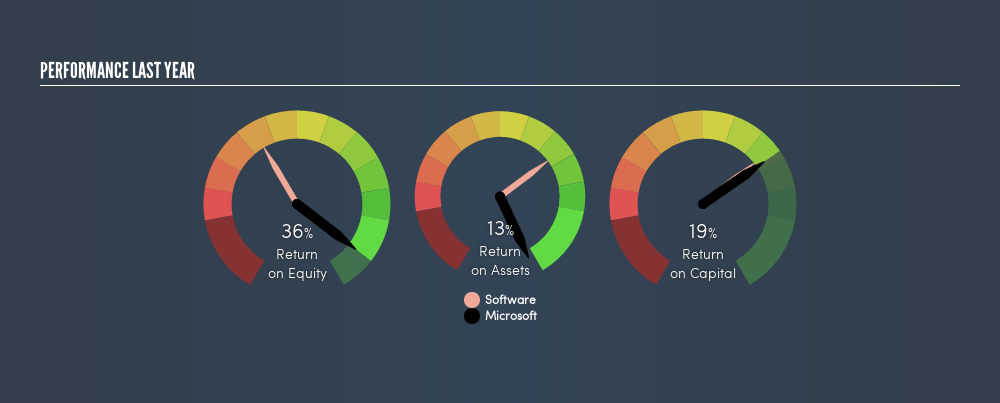Today we’ll look at Microsoft Corporation (NASDAQ:MSFT) and reflect on its potential as an investment. Specifically, we’ll consider its Return On Capital Employed (ROCE), since that will give us an insight into how efficiently the business can generate profits from the capital it requires.
First of all, we’ll work out how to calculate ROCE. Next, we’ll compare it to others in its industry. Then we’ll determine how its current liabilities are affecting its ROCE.
Understanding Return On Capital Employed (ROCE)
ROCE is a measure of a company’s yearly pre-tax profit (its return), relative to the capital employed in the business. In general, businesses with a higher ROCE are usually better quality. In brief, it is a useful tool, but it is not without drawbacks. Author Edwin Whiting says to be careful when comparing the ROCE of different businesses, since ‘No two businesses are exactly alike.’
So, How Do We Calculate ROCE?
Analysts use this formula to calculate return on capital employed:
Return on Capital Employed = Earnings Before Interest and Tax (EBIT) ÷ (Total Assets – Current Liabilities)
Or for Microsoft:
0.19 = US$39b ÷ (US$259b – US$50b) (Based on the trailing twelve months to December 2018.)
So, Microsoft has an ROCE of 19%.
See our latest analysis for Microsoft
Is Microsoft’s ROCE Good?
When making comparisons between similar businesses, investors may find ROCE useful. In our analysis, Microsoft’s ROCE is meaningfully higher than the 9.4% average in the Software industry. We would consider this a positive, as it suggests it is using capital more effectively than other similar companies. Regardless of where Microsoft sits next to its industry, its ROCE in absolute terms appears satisfactory, and this company could be worth a closer look.

It is important to remember that ROCE shows past performance, and is not necessarily predictive. ROCE can be misleading for companies in cyclical industries, with returns looking impressive during the boom times, but very weak during the busts. This is because ROCE only looks at one year, instead of considering returns across a whole cycle. Since the future is so important for investors, you should check out our free report on analyst forecasts for Microsoft.
How Microsoft’s Current Liabilities Impact Its ROCE
Short term (or current) liabilities, are things like supplier invoices, overdrafts, or tax bills that need to be paid within 12 months. Due to the way ROCE is calculated, a high level of current liabilities makes a company look as though it has less capital employed, and thus can (sometimes unfairly) boost the ROCE. To counter this, investors can check if a company has high current liabilities relative to total assets.
Microsoft has total liabilities of US$50b and total assets of US$259b. As a result, its current liabilities are equal to approximately 19% of its total assets. Current liabilities are minimal, limiting the impact on ROCE.
The Bottom Line On Microsoft’s ROCE
This is good to see, and with a sound ROCE, Microsoft could be worth a closer look. Microsoft looks strong on this analysis, but there are plenty of other companies that could be a good opportunity . Here is a free list of companies growing earnings rapidly.
If you are like me, then you will not want to miss this free list of growing companies that insiders are buying.
We aim to bring you long-term focused research analysis driven by fundamental data. Note that our analysis may not factor in the latest price-sensitive company announcements or qualitative material.
If you spot an error that warrants correction, please contact the editor at editorial-team@simplywallst.com. This article by Simply Wall St is general in nature. It does not constitute a recommendation to buy or sell any stock, and does not take account of your objectives, or your financial situation. Simply Wall St has no position in the stocks mentioned. Thank you for reading.

These great dividend stocks are beating your savings account
Not only have these stocks been reliable dividend payers for the last 10 years but with the yield over 3% they are also easily beating your savings account (let alone the possible capital gains). Click here to see them for FREE on Simply Wall St.Bagikan Berita Ini














0 Response to "Should You Like Microsoft Corporation’s (NASDAQ:MSFT) High Return On Capital Employed? - Simply Wall St"
Post a Comment